THE DAY WE NEARLY LOST THE CHARTRES
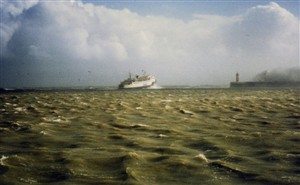
Valencay meets the first swell as she leaves the protection of the breakwater. Then.....
Kind permission of 'macjack'.
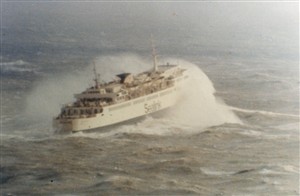
What goes up.....
Phil James, courtesy of Newhaven Museum
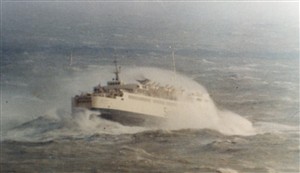
.....must come down!
Phil James, courtesy of Newhaven Museum
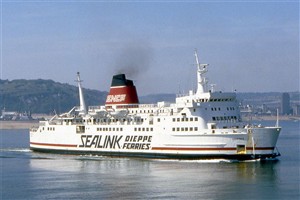
Before - Chartres leaving Dieppe in happier times
Kind permission of Ted Ingham
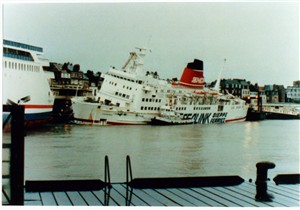
After - Chartres low in the water and listing at Dieppe
Kind permission of Vicky Delaney
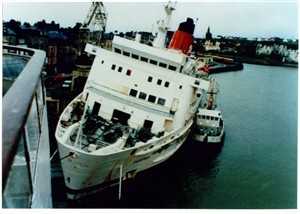
Chartres at Dieppe.
Kind permission of Vicky Delaney
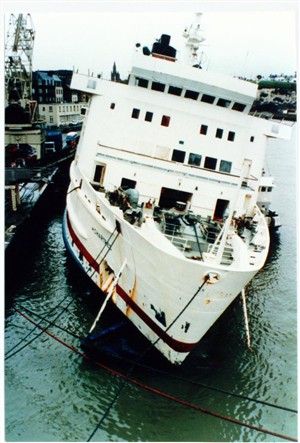
Chartres at Dieppe
Kind permission of Vicky Delaney
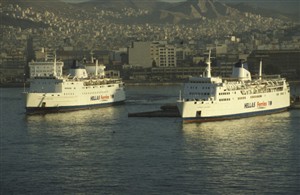
Former Newhaven ships Senlac and Chartres at Piraeus as Express Apollon and Express Santorini.
Kind permission of Harley Crossley
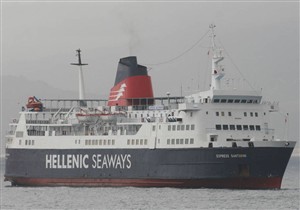
Chartres as Express Santorini
Kind permission of 'gibdan' on Ships Nostalgia
Near disaster for the ferry - not once, but twice.
By Andy Gilbert
Newhaven's cross-channel service to Dieppe once had a reputation that said "We sail in any weather." This goes back to the days when our steamers carried the Royal Mail between the UK and France and the mail 'had to get through', and on time. Our ships were often referred to as the 'mailboats' for this reason, and the British vessels such as Brighton, Londres and Worthing were entitled to the prefix RMS, standing for Royal Mail Ship.
It's been said that the Newhaven ships would still be running long after the Dover ships had headed for shelter and I can certainly remember them sailing in the foulest of weather conditions. The first three photos illustrate this very well, the first is from 'Macjack' and the next two are from a well-known sequence taken by Phil James and held at Newhaven Museum. They all show Valencay leaving Newhaven in the teeth of a gale in September 1974. (I know just how her passengers must have felt as I once made a crossing over on Caledonian Princess and back on Falaise in a force 10/11.) This carried on through all the Sealink years and right up to when SNAT ran the route as Dieppe Ferries in the late 1980's. However, all this changed on the morning of Thursday 25th January 1990. (Please click on the top photo for a link to the weather report page).
The weather that day was very similar to that of the much more famous 'great storm' of October 16th 1987 and it's worth Googling for this, as there's some fascinating information to be read. I was on the day shift at Gibbons Freight's office in what was called the 'agents' village', the small collection of portakabins that were once located next to the town station. As usual, the office girls had the radio on, listening to Simon Bates' morning show. We heard the travel and weather reports, of course, but our ears really pricked up when we heard the newsreader say that the ferry 'Charlie' was in trouble in the Channel. There was, of course, no such ferry and we realised that it had to be Chartres, which had taken out the mid-morning sailing. A quick phone call soon confirmed this and we listened all the more intently.
Chartres had sailed with 80 passengers and 50 crew, with the weather forecast predicting winds in the Channel of gale force 8, gusting to storm force 10. However, by the time she was around 27 miles out from Newhaven, they had increased to hurricane force 11/12. The massive resulting waves of up to 70 feet, described by passenger Andrew Allfree as being 'like mountains', smashed through the windows of her bridge. This resulted in a total electrical failure and, shortly after, both her main engines came to a stop. She was now adrift at the mercy of the weather and you can imagine what must have been going through the minds of passengers and crew alike. More forward-facing windows were then smashed and reports from the passengers on board at the time say that 'there was water everywhere and furniture was flying around'. The crew swiftly moved all passengers to the comparative safety of the aft cafeteria, which was located on a lower deck, and issued them all with lifejackets.
The ship's Master, Captain Yves Lerouvrer, sent out a mayday call, and Newhaven Lifeboat and a Coastguard helicopter were launched from the UK. In addition, a French navy frigate and a cargo ship were diverted towards her. However, it was decided that the weather was so bad that our tug Meeching would not be allowed to go to her aid, a journey that would in any case have taken many hours. After Chartres had been drifting for around three quarters of an hour, her main engines were restarted and she was able to resume her journey to Dieppe.
The passengers must have been breathing a collective sigh of relief as she approached the French port, but nature had another cruel trick to play. Entering the harbour, she was twice dashed against the pier, resulting in a huge gash below the waterline on her port side some 150 feet long. Water rushed in and, given previous car ferry disasters such as the Wahine and the Herald of Free Enterprise, it was very nearly a case of 'so near yet so far'. However, the seamanship skills of Captain Lerouvrer and his crew, plus the swift assistance of Dieppe's tugs, meant that Chartres was just able to make it alongside the Quai Henri IV. Passengers were disembarked immediately with those injured passengers and crew members being stretchered ashore. Most were put up in a Dieppe hotel, before being able to continue their journeys, but it would be some time before cars and lorries would be unloaded. The three photos show Chartres moored at the main ramp in Dieppe, low in the water and with a heavy list to port.
Given the weather conditions and the near disaster, there was much criticism of the decision to sail, and it was pointed out that Chartres had been involved in a similar incident in January 1983. On that occasion too her bridge windows had been smashed and all engine power lost for a time. Much damage was done on the car deck, where several lorries broke their lashings and overturned. However, Dieppe Ferries were quick to point out that Captain Lerouvrer's decision was based on the most up to date weather forecast available to him at the time and insisted that 'no pressure was put on him to sail'.
Chartres was eventually pumped out and refloated, and towed to Rouen for major repairs, which included total rewiring. She never returned to the Newhaven route, her place being taken temporarily by the chartered Belgian ferry Prince Laurent and then permanently by the much larger Champs Elysees in the summer of 1990. Like so many channel ferries, Chartres was sold to Greek owners and became Hellas Ferries' Express Santorini. As far as I know, she's still operating, though safety regulations mean that time is ticking away for all ferries of her age. The final two photos show her a few years ago at Piraeus with Express Apollon, once our very own Senlac, and on her own at Piraeus after her repaint into Hellenic Seaways colours had restored her almost to her original 1974 SNCF appearance.
I cannot recall any of our ferries sailing in such conditions since then, and many is the time I had to placate a disgruntled lorry driver, complaining about a cancelled sailing, with the words 'Do you really want to go out in a force 12 hurricane? No? Well, neither does the Captain!'